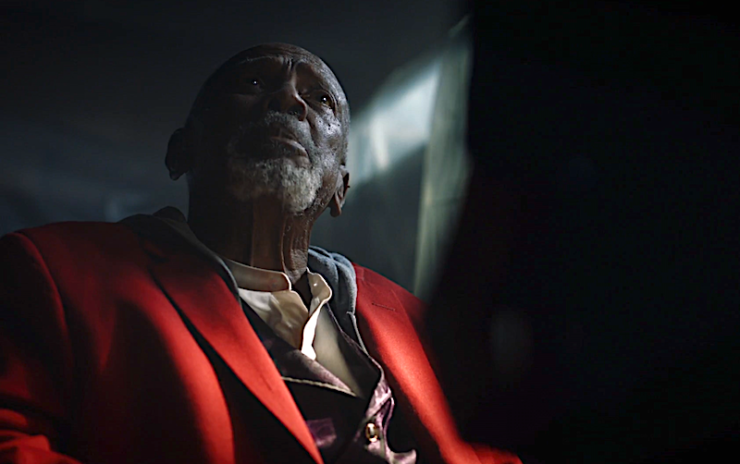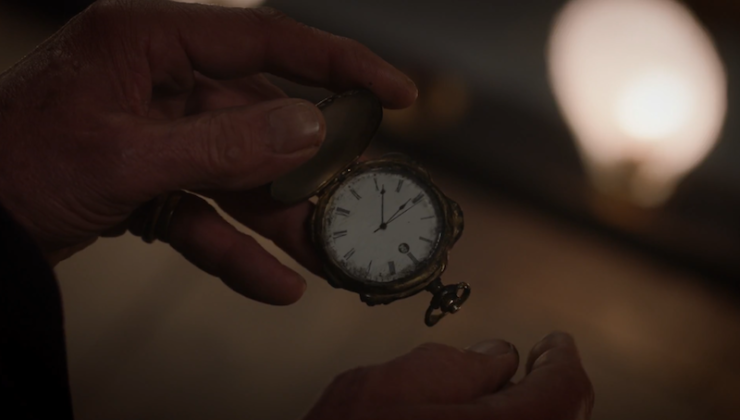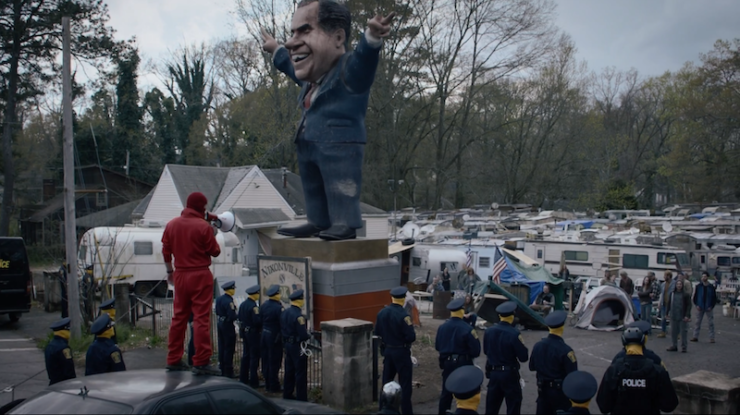Apologies if my every review of this show opens with me just capslocking all over the place, but WHAT WAS THAT?
WHAT IS GOING ON?
WHAT IS YOUR ENDGAME, SHOW?
Ahem.
This week’s Watchmen was, for the most part, riveting. And occasionally, confounding! And there’s so much to talk about! But once again let me say that this show is doing so much more than I was expecting, and if you’re not watching it, you should be. Join me below.
I figured I’d dig into the previous week’s episode at the start of each of these reviews, since presumably all of you reading this will be caught up? This way we can have a more in-depth conversation with a week to ruminate on the story as it unfolds. Therefore:
Last Week, On Watchmen:
One of the many good things that came about because of last week’s episode was, apparently, that a lot of (white) people learned that the Tulsa Race Riots Terrorist Attack Massacre was a real thing. Now, perhaps you’re a white person who is hoping that at least this was an isolated incident? It was not. I’m not the best person to tell you about this history, but Michael Harriot of The Root probably is! And he took the time to put an incredibly informative Twitter thread together that discusses some of the other massacres and terrorist attacks that swept through the country in the wake of the Civil War. It’s a hard read, but you should definitely take the time (a lot of this probably wasn’t covered in your history classes) because it puts the Tulsa Massacre in some context: this pattern of whites attacking and, in many cases, utterly decimating thriving Black communities happened all over the country.
Now, why am I talking about all of this? Because pop culture, like history, does not occur in a vacuum. Lindelof and crew chose to focus specifically on race in the America of Watchmen—a topic the comic largely ignored. It is part of the worldbuilding, and of establishing an alternate reality especially, to see how the racial lines are drawn. This ties in directly to a line in the episode about “Redfordations”, the in-universe slur for reparations, which are apparently a lifetime tax break that President Robert Redford enacted for U.S. citizens descended from enslaved people in Watchmen’s timeline. And clearly there are some people who consider that a hand-out or a gift rather than what it is, which is long-delayed, utterly inadequate back pay. Meanwhile, in our timeline, there has been no nationwide system of slavery reparations (and, surprise, there still isn’t much support for it among white people in the U.S.), and the Supreme Court declined to hear a 2005 case for reparations specifically for the elderly survivors of the Tulsa Massacre. In light of all that context, Lindelof is clearly introducing us to a world in which some of the racial violence of the United States has been addressed in a systemic way, and as a result, it seems knots of white people feel that they are being persecuted. Some have gone off the grid into “Nixonvilles” to retreat from Redford’s government; the Seventh Kavalry, which reveres Rorschach, uses one as its headquarters.
Building on that structure, the traffic stop scene is set up as a racially-charged good faith/bad faith argument. The officer, who is Black, is following the rules, being polite, asking for consent to film the man he’s stopped, who is white. As we learn a few minutes later, the officer is also unarmed at this point, and thus poses no physical threat to the man he’s stopped, and he’s expecting the man to engage at the same level. The man must know this, and instead challenges the officer’s right to wear his mask, which is not just legal but a required part of the police uniform. The stoppee attacks the officer because he sees black skin behind the mask, and he doesn’t consider Black people human. (Although it might not matter if he’d been white, since he probably sees anyone willingly working with Redford’s government as a “race traitor”.) The officer had no chance at having an equal interaction. The man he stopped isn’t engaging with him as an equal, a person with a life, he’s seeing him purely as an obstacle that needs to be removed, and symbol of What’s Wrong With The World. Every inch of my skin was prickling as I watched this interaction, because I’m a person who works on the internet, the Heaven that welcomes Bad Faith Arguments when they die.
This scene is particularly tense because it’s a mirror of the kind of violence that happens in our timeline when innocent people are stopped for Driving While Black. First the writers create a particular power dynamic by having a Black officer stop a white man driving a pick-up truck, but then that power is undercut as we see that the Watchmen-verse has strict protocols about gun use. The audience doesn’t know what that hidden Rorschach mask means yet, only that the officer feels the need to defend himself. By the time we we realize that the stoppee is indeed an armed white supremacist, the show has linked its universe’s racism and terrorism to its own past Tulsa Massacre, as well as to our universe’s traffic stop. Our timeline’s racial tensions have been tangled with those of Watchmen.
By the end of the episode we’ve seen a white man lynched, but we don’t know why. Was Officer Judd ambushed by the Seventh Kavalry, and lynched as way to terrorize the Black community? Or was the Chief himself a secret Seventh Kalvaryman? He was listening to right-wing radio in the privacy of his truck—but that could also be research, as he knew he was battling conspiracy-minded white terrorists. Now this week—but hang on, I’ll discuss that in the spoilery section below.
Over the course of the episode we saw white mobs attacking a Black community in the past, and we’ve seen two specific, racially-coded incidents of violence in the present, in a narrative that is explicitly about fighting a white terrorist cell—and the writers are simultaneously showing us the most probable legacy for Rorschach’s brand of paranoiac vigilantism. This is a lot, and I’m really hoping that the show keeps this taut balance and pays it all off by the end.
Now, on to some slightly lighter topics:
How about that interrogation scene??? My colleague Evelyn Wang mentioned that it was pretty Banksy-esque, and I have to agree with them—I’m pretty sure people would pay MoMA $50 for a timed ticket to that experience. I really loved how the show played with the imagery, flashing back and forth between iconography of our timeline, and Watchmen-specific images that would have gained their own life in that timeline. I was especially pleased about the juxtaposition of the Twin Towers and Wade asking if the suspect thought Veidt’s squid was a hoax. Are the Towers still standing in the Watchmen-verse?
I’m also seeing a debate about whether Jeremy Irons is playing Veidt-in-hiding, or possibly Doctor Manhattan. I was purely #TeamVeidt, but I’d love to be wrong.
This Week, On Watchmen:
Where last week’s episode opened on the Tulsa Massacre, this one opens in World War I-era Germany, where the German army is typing up leaflets to convince Black soldiers to defect. As the leaflet points out, why should Black soldiers risk their lives for “democracy” when they don’t actually get to live under it? We focus on one man reading his pamphlet, who turns out to be the father of Will, the little boy from last week’s opening. The man came home from war, and was murdered on his own land.
This episode did a fantastic job of adding to the worldbuilding and filling in gaps. Angela investigates Judd’s murder, interrogating the elderly man privately (and much more politely than she interrogates most people) but the man remained largely a mystery. We got some backstory on her friendship with Judd, and on what exactly happened during White Night. We learn more about the Tulsa Massacre, and how the government of Watchmen’s universe attempted to grapple with its past. We also see more of a Nixonville, and get more of a sense of how pop culture works in a world that has real superheroes in it.
The scene between Regina King and Louis Gossett Jr. is just gorgeous. There is so much packed into the clues he’s throwing to her, her anger and grief, and so much oddly twinkling humor in his parrying of her questions. I also appreciated that the show stopped and gave us some time with Angela and Wade in her car, the two coworkers trying to pull themselves together enough to investigate their boss’s horrific murder. King and Tim Blake Nelson are both SO GOOD together—the two share an amazing weariness, and spiky chemistry that I hope the show explores further.
But mostly this episode just raised even more questions than it answered.
Here Be a Black Freighter Full of Spoilers:

OK, why is there a whole-ass KLAN SHEET in Judd’s closet? That is a very literal interpretation of the phrase “He has skeletons in his closet.” Angela is now having to investigate her boss/friend’s murder, and, most likely, his past as well. I really liked that she questions the sheet, and immediately assumes it’s been planted, because that is an extremely obvious clue. Too obvious.
We also get more hints that there is more to Will than we first see, as he’s able to escape Angela’s bakery, go buy eggs, and come back. Then, obviously, the whole episode cracks open when an airship swoops down and steals Angela’s car with him in it. We do learn that he is apparently Angela’s grandfather. Does he have powers?
We also learn that Angela and Cal’s kids were adopted when Angela’s partner, Doyle was murdered along with his wife on White Night. This also explains why Angela and Topher have a somewhat more brusque and quasi-adult relationship than the one she has with the two girls; it was Topher who remembers what happened to their parents, and he was the one who hid his sisters until help came.
But speaking of White Night: in Angela’s flashback, we can clearly see that two Rorschachs came into her house to murder her. She only stabbed one. Yet somehow she survived, and Judd refers to her having “Got her man.” So again, Judd is hiding something. I just hope it isn’t the incredibly obvious thing.
The entire section at the castle is unsettling. Is Jeremy Irons playing Veidt, who is obsessively rewriting Doctor Manhattan’s origin story? Or is this Manhattan himself, with Angela lampshading the idea that Manhattan can’t look human, so that the real answer hides in plain sight? How human are his servants? Those sound like real screams of pain when he incinerates one of his Mr. Phillipses, and the others do seem somewhat upset and nervous.
Allusions:

- Clocks just everywhere, man. The large grandfather clock ticked over to midnight just as the White Night attack began; Jeremy Irons’ character’s watch played a vital role; an egg timer signaled an important revelation.
- The kids are playing pirates—just as in the original Watchmen, pirate comics seem more popular than superheroes.
- The play that Jeremy Irons’ character has his servants perform is a re-enactment of the accident that turned Jon Osterman in Doctor Manhattan. The scene features a servant being burned alive in a box, just as Jon was, and a new servant being lowered on a platform painted bright blue, with the iconic Manhattan mask on. The director made a point of zooming in on Manhattan’s penis in what is probably the funniest reference that will ever be made to Snyder’s film. (Unless they’ve shelled out for the right to a Leonard Cohen song or two.)
- We see a re-enactment of Hooded Justice’s superhero origin story on an episode of American Hero Story. At one point a terrified shopkeep gasps “WHO ARE YOU?” in a perfect parody of one of the goons in Tim Burton’s Batman, and Justice replies: “Who am I? If I knew the answer to that I wouldn’t be wearing a fuckin’ mask.”
- Seriously, when I said the thing last week about Tom Mison returning to my Sunday nights I was not anticipating quite so much Mison!
- This might just be me, but at one point a pair of citizen journalists swoop over a murder scene in flying suits that are extremely similar to Arthur’s in the latest iteration of The Tick, so when Red Scare takes one of them down, it really looks like Ben Edlund’s parody-also-known-as-Red-Scare is beating the tax returns out of Arthur.
What do you all think? Who are Will’s friends in high places? Is the man in the castle Veidt, plotting some sort of horrific deed, or Manhattan…plotting some sort of horrific deed?
Leah Schnelbach could seriously watch two hours of that play. Come debate the merits of blue bodypaint with them on Twitter!










